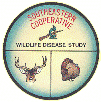Southeastern Cooperative Wildlife Disease Study

Southeastern Cooperative Wildlife Disease Study: Publications
Document Type
Article
Date of this Version
October 2003
Abstract
• Johne's Disease and Southeastern White-tailed Deer: Paratuberculosis or Johne's disease, caused by the bacterium Mycobacterium avium subspecies paratuberculosis (Mptb), occurs worldwide and is recognized as a significant health problem for domestic ruminants, wild ruminants in zoological collections, and farmed cervids. SCWDS recently completed a culture and serologic survey for Mptb infection among white-tailed deer populations in the southeastern United States.
• SCWDS has been involved in exotic tick research and surveillance throughout the United States and the Caribbean region for over 25 years, and surveillance efforts now are being expanded in the southeastern United States and Puerto Rico. One current concern is the tropical bont tick, Amblyomma variegatum. This tick is native to Africa but also is established in the Caribbean. It is a vector of heartwater and African tick-bite fever and is associated with acute bovine dermatophilosis. Heartwater is a rickettsial disease of ruminants known to be present on three islands in the Caribbean, and in experimental trials it was fatal to white-tailed deer. Acute bovine dermatophilosis affects cattle in the tropics, and African tick-bite fever is a disease of humans. Both diseases also are present in the Caribbean.
• A second area that is gaining additional attention is research on Johne's disease, or paratuberculosis. Johne's disease is caused by the bacterium Mycobacterium avium subspecies paratuberculosis (Mptb).
• Surveillance for Human Ehrlichioses Agents Using White-tailed Deer: SCWDS has been conducting research on the natural history of two emerging tick-borne human pathogens, Ehrlichia chaffeensis and Anaplasma phagocytophilum, among white-tailed deer across a multistate region.
• Characterization of Ehrlichia chaffeensis from Deer: we investigated the genetic variation of Ehrlichia chaffeensis from naturally infected white-tailed deer. Ehrlichia chaffeensis causes human monocytotrophic ehrlichiosis (HME) and is an important emerging tick-borne pathogen in the southeastern and southcentral United States. Ehrlichia chaffeensis is maintained in an epidemiologic cycle involving white –tailed deer and the lone star tick.
• GIS-Based Pseudorabies Surveillance: Pseudorabies virus (PRV) has been nearly eliminated from the nation's domestic swine herd. However, feral swine in 10 states have tested seropositive for PRV, and SCWDS studies have shown that once infected, feral swine populations remain infected indefinitely.
• Exotic Newcastle Disease Quarantine Lifted: The presence of END in this outbreak was first confirmed in California on October 1, 2002. END is a contagious and fatal viral disease that affects the respiratory, nervous, and digestive systems of birds and is one of the most infectious poultry diseases in the world.
• Pentobarbital Poisoning of Eagles: The United States Fish and Wildlife Service (FWS) has issued a press release regarding accidental poisoning of eagles by pentobarbitol, a commonly used euthanasia drug.

